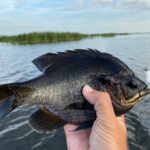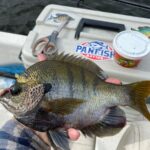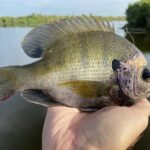Nothing is more relaxing than casting a line into a pond on a warm afternoon while you sip an ice-cold beverage…
And pond management is a growing industry…from residential neighborhoods to city parks and ranches, there is a lot to know to keep your pond and fish healthy.
In this guide, I’m going to tell you what to feed crappie in a pond. I’ll answer a few commonly asked questions and cover the dos and dont’s for this popular panfish.
Table of Contents
What Do You Feed Crappie In A Pond?
Crappie are notoriously picky when it comes to eating pelletized fish feed. To properly feed and manage crappie in a pond you should focus on creating proper bluegill spawning habitat and cover for baitfish to ensure an ample supply of natural forage for crappie to eat.
Instead of thinking what do I need to ‘add‘ to my pond to feed the crappie, ask yourself “what can I create in my pond to foster a healthy ecosystem for crappie“.
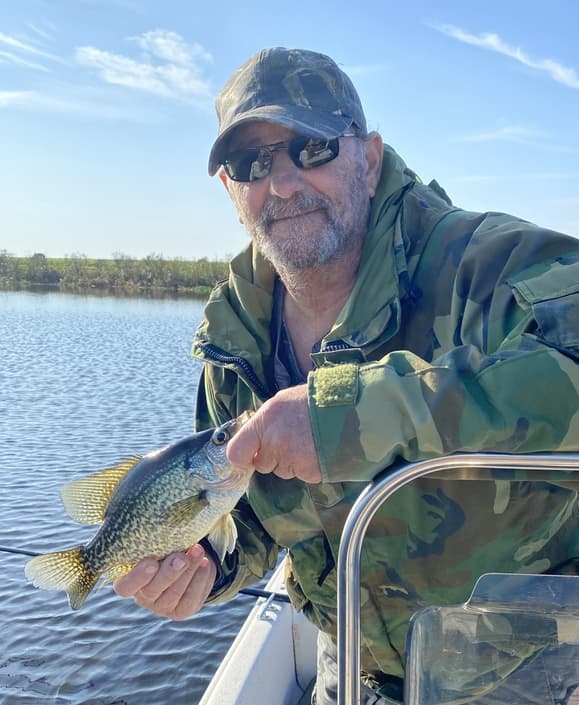
Crappie are fine at fending for themselves…in fact, they will often eat everything in your pond if left unchecked!
That is why It’s more important to create a renewable supply of baitfish and a healthy ecosystem if your focus is to manage crappie.
This process involves managing forage (bait) and predators (such as largemouth bass).
What Do Pond Crappie Eat?
Pond crappie eat the same natural foods as other crappie found in lakes, rivers and reservoirs all over the country. Throughout their lifecycle, crappie feed on microscopic zooplankton, insect larvae, crustaceans like grass shrimp and baitfish such as minnows and shad.
The main difference between pond crappie vs other stocked species is that it can be very difficult to get pond crappie to eat pelletized fish food.
Unlike bluegill or striped bass that will readily eat protein pellets on the surface, crappie are a bit more difficult.
The most successful pond owners optimize their pond for crappie by creating the correct habitat, culling fish frequently, and monitoring growth rates.
Best Crappie Bait For Ponds
The best crappie bait for ponds is a steady supply of natural forage and baitfish for the crappie to eat. This is usually juvenile bluegill (less than 3 inches), mosquitofish, shiners, shad, or fathead minnows.
Plus all the other good stuff that grows in a nutrient-rich and healthy pond like crustaceans, insects, larvae, eggs, etc.
The most common way to achieve a steady supply of natural forage fish to grow big crappie is to create bluegill spawning habitat and have a balanced pond ratio of bass to bluegill.
You May Also Like: The Best Crappie Baits To Catch Slabs All Year Long
Small bluegill from 1-3 inches are excellent crappie food. And they are relatively easy to grow and proliferate.
The key is to keep the crappie from getting overpopulated so the bluegill have a chance to reach 1-3 inches in size.
If you have too many crappie, they will eat all the bluegill before they even have a chance to get that size.
You can manage the crappie with an aggressive culling program, and by stocking hungry and aggressive young bass in the 12-16 inch size range.
Are Crappie Bad For A Pond?
Crappie can be bad for a pond if you are not managing for crappie. They are prolific spawners and grow very quickly, therefore crappie can quickly overpopulate a pond which can create an imbalance and lead to stunted fish, or poor forage distribution.
This is especially true in small ponds with no fish management plans. They are often filled with thousands of small 6-8 inch crappie, with almost no other size or species present.
That’s a clear sign the pond is overpopulated with crappie, which will make growing other popular fish species like largemouth bass or bluegill more difficult.
An overpopulation of crappie in a pond can lead to all sorts of problems, from fishy smells to fish kills.
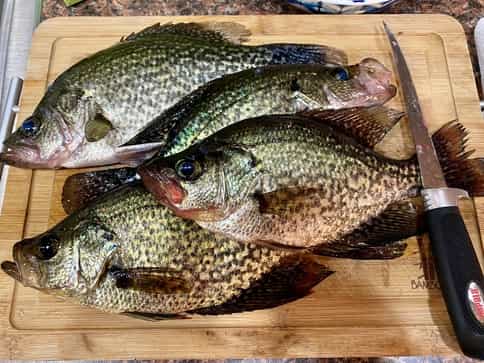
But if your goal is to grow and raise crappie, then of course they’re not bad for a pond.
Crappie adapts to ponds very well when properly managed but there are some dos and donts.
How Do You Raise Crappie In A Pond?
First, I always recommend getting in contact with a pond manager or fisheries specialist in your area to determine the best plan of action to raise crappie in your pond.
(Hint: Contact your local county agricultural extension office)
Every pond is different, but here are few things to consider:
- Consider stocking your pond with black crappie instead of white crappie. Black crappie are much more popular at fish farms and adapt best to small-medium-sized ponds.
- Crappie are sight feeders, so if your pond is muddy and silty you may be wasting your time. A good rule of thumb is your pond should have 16-24 inches of visibility.
- Use predator fish like largemouth bass to your advantage. Consider stocking bass alongside your crappie, and maintain a healthy population of 12-16 inch bass to feed on crappie and keep the population from growing too quickly. This means keeping and culling larger bass.
See Also: Are Largemouth Bass Good To Eat? And Should You Keep Them?
- Consider doing a rotating drawdown of water levels every other year. By reducing the water level by 50%, the bass will be able to hunt the crappie much easier and keep the crappie population in check.
You see, raising crappie in a pond is all about balance. And without proper management, a crappie pond can get imbalanced quickly.
And if you want to raise BIG bass and crappie at the same time? Forget it. These are competing species and it’s incredibly difficult to do in small pond ecosystems.
How Deep Does A Crappie Pond Need To Be?
It is a common misconception that crappie need very deep areas in order to spawn and thrive. While studies have shown crappie spawn and feed in areas as deep as 20+ feet, they are capable of flourishing much shallower, from 3-8 feet deep.
What’s more important than pond depth, is pond habitat. Crappie need some type of structure to deposit eggs: These can be submerged stumps, weeds, rocks, or even PVC crappie trees.
Next, you need to be sure you have adequate forage and predators to keep the crappie well fed and the population in control.
What About Hybrid Crappie For My Pond?
A hybrid crappie is a cross between a black nose crappie and white crappie, which results in a less prolific and faster-growing species of crappie.
That means they grow quicker, but breed slower. This is great if your trying to keep your crappie population under control.
Various fish farms throughout the United States offer hybrid crappie (sometimes called Magnolia Crappie).
Stock, variety and prices may vary so your best bet is to call around and find what’s available in your area.
Below are a few suppliers:
You May Also Like: Hybrid Bluegill vs Bluegill…Revealing Differences
Conclusion
Crappie are a beloved fish. They are fun to catch, they are beautiful to look at, and they are delicious to eat.
That being said, they are one of the more difficult species of fish to raise and manage in ponds. Can it be done? Absolutely.
But take your time to do your research, consult with a professional and create a plan that suits your goals.
Otherwise, you may be throwing money down the (pond) drain!
You May Also Like: Why Does My Pond Only Have Small Bass? Here’s Why!
If you haven’t guessed yet, I love fishing and everything about it!
To learn more about why I started Panfish Nation, visit the About page and follow along on Social Media:


Download a copy of my FREE Lure Color Selection Chart & Knot Guide!
Stay up to date with fishing reports, tackle reviews, industry news, and much more! We respect your privacy, unsubscribe at any time.
Related Posts
- Crazy Facts About the World Record Crappie
- What Size Hooks for Smallmouth Bass? Quick Guide
- Large and in Charge-Mouth: 10 of the Best Bass Lures of All Time (And Where to Buy Them)
- Emperor of the Sun(fish): What You Need to Know About the World Record Bluegill
- Coppernose Bluegills: How They’re Different from Common Bluegill
- Bluegill vs Brim: Differences & Terminology, Explained!




